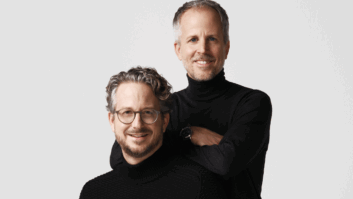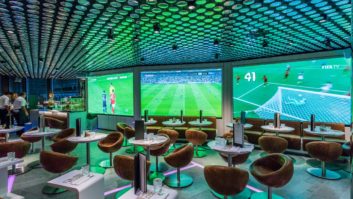
Following the Saville Group’s recent rebranding, Duncan Proctor talks to Dave Willie, head of marketing and product management at Visavvi, about the advantages this offers the business, as well as the constantly changing corporate AV landscape
Can you explain the thinking behind the rebranding?
We work in a constantly changing technology sector, one that has always evolved but the pace of change has accelerated rapidly over the last 2-3 years. As a business Saville Audio Visual effectively had two business operations; system integration and live events. Both sides of the business address a completely different client base, each with a totally different set of needs. Positioning ourselves in the market as one generic organisation covering both sectors was in fact limiting. While this has generated success for the business over half a century, times change and we felt that the single brand was not reflecting our true capabilities to address the requirements of each sector.
The creation of the Visavvi and Sparq brands respectively, under the corporate parent brand Saville Group, allows us to focus totally on specific client needs while drawing on all the heritage and industry knowledge the business has gained over the last half century.
How will it benefit you as a business going forward?
The benefit for all areas of our operation is absolute clarity about our focused offerings. In the past our single brand approach to two completely different market sectors appeared a little too fragmented, often confusing clients and not truly reflecting our deep understanding of our clients’ challenges and requirements.
Our two dedicated client offerings now have their own distinct brand which provides them with the freedom to directly address their respective markets.
Visavvi is the AV services brand. How will its offering differ from what Saville AV was able to provide?
There isn’t a difference to the offering. Of course, we add new services, new solutions and new products all the time. As we’ve seen over the last few years there are increasing levels of IT, cloud, communication and collaboration technology and professional services within our sector and ‘Audio Visual’ just doesn’t do justice to the wide range of solutions and services we provide to clients anymore.
Fundamentally we are the same business, the same highly experienced people providing a wide range of services and solutions focused on driving business agility through technology for our clients. Visavvi now provides a brand platform that really showcases our abilities and business services in a much more focused and targeted way than Saville Audio Visual can.
How are you adapting solutions to the convergence of AV and IT?
Our extensive experience of blending technologies from multiple manufacturers enables us to create bespoke environments on behalf of our clients. We continue to possess and expand our high levels of accreditation and knowledge with many leading industry brands and products, allowing us to mould the best of the industry and transform them into intuitive, easy to use environments for clients. With many of today’s AV products being dependent on IT connectivity, we see the convergence of AV and IT as offering a substantial opportunity for us and our clients to harness the operational benefits that this provides. We have introduced relevant skillsets across our teams to ensure that our solutions deliver seamlessly across networks, addressing the current focus on digital transformation within the workplace on a global scale.
Do you think the percentage of meeting rooms/spaces with a good standard of AV is still in the minority?
AV has become much more strategic in organisations, which is a substantial shift from a few years ago. We are seeing many organisations focussing a higher priority on creating environments where employees are empowered by technology rather than hindered by it. These companies realise that staff have access to unprecedented levels of technology outside of work, such as smartphones, tablets, smart TVs, voice control devices, video calling and therefore to keep them engaged, motivated and empowered they need to offer business grade equivalents to what they use outside of work.
A few years ago, it was a case of users wanting technology in meeting rooms, now it’s a case of demanding it. Today people make important career decisions based on the type of environment they will be working in and the access to appropriate tools to empower and develop their progression.
Of course, there are going to be environments which don’t deliver the experience users expect, and organisations that fail to adapt to the user journey may struggle to retain or recruit people of the right calibre for the business to prosper.
How are you dealing with the ever-changing security threat in corporate environments?
We regularly review and add to our technology and services portfolio. As the Internet of Things rapidly expands, increasingly our solutions and services are potentially exposed to security threats in a way that discrete AV technology never did. We managed this in a number of ways, our product management team who are responsible for researching new solutions and products for the business portfolio evaluate possible risks and identify processes to help mitigate or reduce any potential issue. We are very aware that clients may not fully understand the implications of adding technologies they specify to their networks. For example, the potential impact or danger of adding a domestic voice control device like they use at home to a boardroom that actively listens to every word and relays this to an open cloud service over the public internet. Our responsibility is to ensure that security implications and potential threats are highlighted to clients during consultation. We constantly review the training of our sales teams, project managers and engineers to ensure they have awareness of this through webinar workshops with a specialist cyber security partner.
Is there a sense that the IT department is taking over many of the integrator’s responsibilities or has this not been your experience as of yet?
I don’t think we see IT departments taking over the responsibility of integrators, rather they are becoming more engaged with us. And I don’t blame them. If I was responsible for business-critical IT provision and a new range of units were about to be deployed across my network, I’d want to know everything about it. AV in the past was an isolated technology, if something failed the worst thing to happen would be an individual room would be out of use. When AV solutions encroach onto a corporate network, it brings much wider risks which could impact on business critical applications, processes and tools. The more IT departments become engaged with AV integrators the better for all.
What are the meeting room solutions you would invest in right now that you think will still be relevant in a few years’ time?
It really depends what the application is. We are seeing more and more informal meeting spaces or huddle rooms. These are typically suited to small meetings bringing teams together to discuss a specific task or problem. Because these spaces are used by a wide range of people to undertake a wide range of tasks, they have to be highly capable and extremely easy to use. Collaborative touchscreens have emerged as a technology many organisations seek to provide to their teams. The ability for multiple users to interact collaboratively with content on the fly is really accelerating business agility and improving business outcomes for organisations, especially when these teams are sometimes virtual and in different locations around the globe.
Technology is always going to evolve but increasingly these days much of the intelligence is within the software of a hardware product, this then provides greater scope for upgrading the software to match current demands extending the life of the hardware product its hosted on. Solutions such as Microsoft Surface Hub, Avocor, Dell, Clevertouch, NEC collaboration screens are driving this sector of the market and each is powered by a software environment allowing clients to install their chosen set of applications and upgrade the environment when required. Cloud is definitely leading the way.
How has AV technology developed to facilitate the trend towards smaller, faster, more flexible meetings and the rising popularity of huddle rooms?
The rise of huddle spaces has created a whole plethora of solutions specifically designed to suit this type of environment. These predominantly provide the ability for users to use their own laptops as the central resource and provide USB connectivity to devices such as interactive collaboration screens, USB video collaboration devices such as AMX Acendo, Yamaha CS700, Logitech video, Crestron Mercury, Huddly and content sharing solutions such as Barco Clickshare. Many of these have the potential to then connect into a wider network allowing agile working across a business estate on a global scale.
What are the advantages and disadvantages of workplace collaboration solutions becoming more integrated and interconnected?
It’s all about having the ability to create tailored environments that match client needs. The more solutions are integrated the easier they are to use, support and manage and the greater the capabilities for the user using them and to the business as a whole, driving engagement, productivity and ultimately increased ROI.
How do you see things changing for the traditional AV integrator? Will they have to choose between offering a broader range of services or becoming more specialised?
I’m sure each integrator will have their own strategy and approach. Our approach has been consistent for over 50 years to provide a range of innovative technologies, solutions and services tailored to each specific client need. Every time striving to deliver environments that provide business benefits for our clients beyond their expectation.







